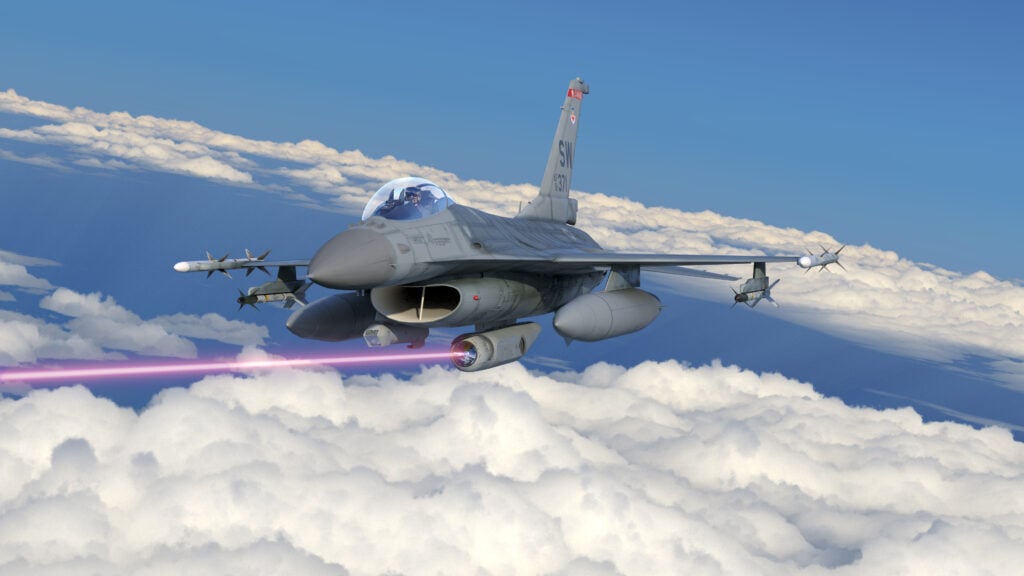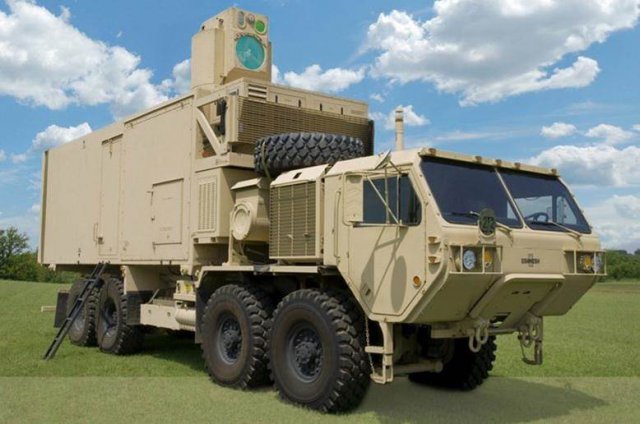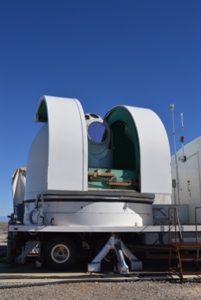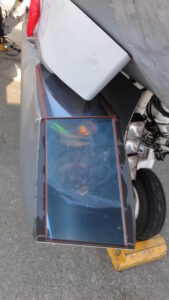
Lockheed concept for a future anti-missile laser pod firing from an F-16 fighter.
WASHINGTON: “Lockheed Martin is working to fly a laser on tactical fighters within the next five years,” Lockheed laser expert Mark Stephen told reporters yesterday afternoon. “We’re spending a lot of time to get the beam director right.”
That beam director, which keeps the laser beam on target, is a crucial but easily overlooked component of future laser weapons.
The Air Force Research Lab’s SHiELD program aims to put defensive laser pod on fighters to defend them against incoming anti-aircraft missiles. An offensive laser to shoot down enemy aircraft would have to hit harder and at longer distances, so it’s a more distant goal: Such weapons are envisioned for a future “sixth generation” fighter — like the NGAD prototype now in flight test — to follow the 5th-gen F-35, while the SHiELD pod will go on non-stealthy 4th gen aircraft like the F-16, as in this Lockheed video.
But the company’s new beam-director design is actually getting its first workout on an Army system, the truck-mounted IFPC Energy Laser, which will defend against artillery rockets, drones, and, potentially, subsonic cruise missiles.

An early Army HEL (High Energy Laser) Mobile Demonstrator
The first unit of IFPC-HEL prototypes, already under construction, will be operational in 2024. That’s a year ahead of Lockheed’s timeline to put a laser on a fighter. And the fighter-pod project isn’t trying to field an operational prototype, either; It’s just trying to demonstrate the technology can actually work, with a formal requirements document and acquisition program of record to follow in the mid-2020s, when the Army plans to already have IFPC-HEL in mass production.

The Air Force Research Laboratory’s Demonstrator Laser Weapon System, used in testing for SHiELD.
Why the difference in timelines? It is much, much easier to mount a working weapon on a truck than on a fighter jet. For one thing, the truck isn’t moving at hundreds of miles an hour, and having that stable firing platform makes aiming much simpler.
The truck also has a lot more room for power generation and cooling systems than a pod that fits under a fighter. IFPC-HEL will produce 300 kilowatts of power; SHIELD’s output is TBD, but it’ll probably be under 100 kW, allowing the fighter to charge the laser without installing a whole new power generation system.
Now, it’s easy for discussions of laser weapons to boil down to counting kilowatts, and power output is important – but so is precision. Sure, more power lets you do more damage, more quickly, at longer ranges. But you have to actually hit the target first. And that’s especially hard because most laser weapons in development, like SHIELD and IFPC, are intended to defeat fast-moving threats like rockets, missiles, and drones.
Then you have to keep hitting the target long enough for the laser beam to heat it up enough to hurt it, even if that’s just a fraction of a second. (Lasers are less like explosions or bullets, which apply their kinetic energy in the instant of impact, and more like blowtorches, which apply heat energy over time). In fact, precision can trump power, up to a point, because the more precisely you can hold the laser beam on the exact same spot, the faster it burns through.
Getting the laser precisely on target and keeping it there is the job of the beam director. It has to pull in sensor data on the current locations of both the target and the firing platform. Sophisticated software predicts exactly where the beam needs to go and adjusts specially designed mirrors to bounce the laser light in just the right direction. And the beam director has to keep making those calculations and adjustments many times a second.
Can you really achieve this kind of precision from an aircraft in flight, which is not only flying at hundreds of miles an hour but vibrating?

Sniper targeting pod (front view)
Lockheed’s been doing it for decades, Stephen said. It makes the Sniper Advanced Targeting Pod widely used on US and allied aircraft since 2006. Sniper uses multiple sensors – including lasers – to pinpoint targets for precision-guided airstrikes.
“It has lasers inside of it that have to be maintained onto a target during high speed maneuvers,” Stephen said. “They’re laser designators, not weapon-class lasers,” he acknowledged, but that’s a difference in power level, not precision.
“They still have to maintain the position on the target to deal with the vector in the weapon that they’re guiding. So the technology and the algorithms, developed over the last 40 years on those types of electro-optical systems with laser designators in them, are directly applicable from a pointing and jitter control standpoint,” he explained.
Lockheed beam-control development didn’t stop with Sniper. “We conducted 62 flight tests over an eight-year period to optimize laser focus and stability,” Stephen said. “We have established a new directed energy system integration lab” in Orlando, Fla. that will be testing lasers up to 50 kW next year and up to 150 kW by 2024.
And to build the precision systems at the scale and cost required for a practical procurement program, he said, “we’re investing over $20 million in our Orlando-based optical components center to expand the manufacturing footprint by 40 percent.”
Lockheed is supremely confident in their laser tech. As another exec, Paul Shattuck, boasted on an earlier occasion: “Our beam control technology enables precision equivalent to shooting a beach ball off the top of the Empire State Building from the San Francisco Bay Bridge.”
Air Force picks Anduril, General Atomics for next round of CCA work
The two vendors emerged successful from an original pool of five and are expected to carry their drone designs through a prototyping phase that will build and test aircraft.


























